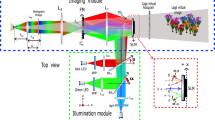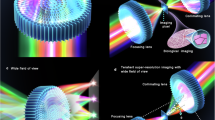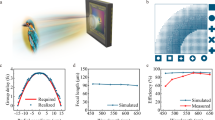Abstract
Metalenses show promise for replacing conventional lenses in virtual reality systems, thereby facilitating lighter and more compact near-eye displays (NEDs). However, at the centimetre scale necessary for practical applications, previous multiwavelength achromatic metalenses have faced challenges in mass production and exhibited a low numerical aperture (NA), which limits their practical application in NEDs. Here we introduce a centimetre-scale red, green and blue achromatic metalens fabricated using a roll-to-plate technique and explore its potential for practical applications in NEDs. This metalens is designed through topological inverse design utilizing a finite-difference time-domain simulation for entire areas (~10,000λ). Our design method demonstrates the ability to compensate chromatic aberrations even at the centimetre scale and high NA with low-index materials such as resin suitable for scalable manufacturing. In addition, we developed a compact NED by integrating the metalens with computer-generated holography (CGH). In this NED system, the high-NA metalens address the limitations of narrow field of view and extensive empty space typical of conventional CGH-based NEDs. The CGH optimization model further resolves the challenges of broadband operation and off-axis aberration in centimetre-scale red, green and blue achromatic metalenses.
This is a preview of subscription content, access via your institution
Access options
Access Nature and 54 other Nature Portfolio journals
Get Nature+, our best-value online-access subscription
$32.99 / 30 days
cancel any time
Subscribe to this journal
Receive 12 print issues and online access
$259.00 per year
only $21.58 per issue
Buy this article
- Purchase on SpringerLink
- Instant access to full article PDF
Prices may be subject to local taxes which are calculated during checkout





Similar content being viewed by others
Data availability
The data supporting the findings of this study are available from the corresponding authors upon reasonable request.
Code availability
The code used for this study is available from the corresponding author upon reasonable request.
References
Zheng, G. et al. Metasurface holograms reaching 80% efficiency. Nat. Nanotechnol. 10, 308–312 (2015).
Chen, W. T. et al. A broadband achromatic metalens for focusing and imaging in the visible. Nat. Nanotechnol. 13, 220–226 (2018).
Chung, H. & Miller, O. D. High-NA achromatic metalenses by inverse design. Opt. Express 28, 6945–6965 (2020).
Rubin, N. A. et al. Matrix Fourier optics enables a compact full-Stokes polarization camera. Science 365, eaax1839 (2019).
Kim, J. et al. Photonic encryption platform via dual-band vectorial metaholograms in the ultraviolet and visible. ACS Nano 16, 3546–3553 (2022).
So, S. et al. Multicolor and 3D holography generated by inverse-designed single-cell metasurfaces. Adv. Mater. 35, 2208520 (2023).
Kim, J. et al. Dynamic hyperspectral holography enabled by inverse-designed metasurfaces with oblique helicoidal cholesterics. Adv. Mater. 36, 2311785 (2024).
Kim, S. et al. Anti-aliased metasurfaces beyond the Nyquist limit. Nat. Commun. 16, 411 (2025).
Wang, P., Mohammad, N. & Menon, R. Chromatic-aberration-corrected diffractive lenses for ultra-broadband focusing. Sci. Rep. 6, 21545 (2016).
Jang, C., Bang, K., Chae, M., Lee, B. & Lanman, D. Waveguide holography for 3D augmented reality glasses. Nat. Commun. 15, 66 (2024).
Shi, L., Li, B., Kim, C., Kellnhofer, P. & Matusik, W. Towards real-time photorealistic 3D holography with deep neural networks. Nature 591, 234–239 (2021).
Peng, Y., Choi, S., Kim, J. & Wetzstein, G. Speckle-free holography with partially coherent light sources and camera-in-the-loop calibration. Sci. Adv. 7, eabg5040 (2021).
Li, Z. et al. Meta-optics achieves RGB-achromatic focusing for virtual reality. Sci. Adv. 7, eabe4458 (2021).
Li, Z. et al. Inverse design enables large-scale high-performance meta-optics reshaping virtual reality. Nat. Commun. 13, 2409 (2022).
Lee, G.-Y. et al. Metasurface eyepiece for augmented reality. Nat. Commun. 9, 4562 (2018).
Gopakumar, M. et al. Full-colour 3D holographic augmented-reality displays with metasurface waveguides. Nature 629, 791–797 (2024).
Shi, Y. et al. Augmented reality enabled by on-chip meta-holography multiplexing. Laser Photonics Rev. 16, 2100638 (2022).
Wang, S. et al. A broadband achromatic metalens in the visible. Nat. Nanotechnol. 13, 227–232 (2018).
Wang, S. et al. Broadband achromatic optical metasurface devices. Nat. Commun. 8, 187 (2017).
Wang, Y. et al. High-efficiency broadband achromatic metalens for near-IR biological imaging window. Nat. Commun. 12, 5560 (2021).
Shrestha, S., Overvig, A. C., Lu, M., Stein, A. & Yu, N. Broadband achromatic dielectric metalenses. Light Sci. Appl. 7, 85 (2018).
Feng, W. et al. RGB achromatic metalens doublet for digital imaging. Nano Lett. 22, 3969–3975 (2022).
Lin, R. J. et al. Achromatic metalens array for full-colour light-field imaging. Nat. Nanotechnol. 14, 227–231 (2019).
Pan, C.-F. et al. 3D-printed multilayer structures for high-numerical aperture achromatic metalenses. Sci. Adv. 9, eadj9262 (2023).
Bayati, E., Zhan, A., Colburn, S., Zhelyeznyakov, M. V. & Majumdar, A. Role of refractive index in metalens performance. Appl. Opt. 58, 1460–1466 (2019).
Taflove, A., Oskooi, A. & Johnson, S. G. Advances in FDTD Computational Electrodynamics: Photonics and Nanotechnology (Artech House Publishers, 2013).
Miller, O. D. Photonic Design: From Fundamental Solar Cell Physics to Computational Inverse Design (Univ. California Berkeley, 2012).
Baek, S. et al. High numerical aperture RGB achromatic metalens in the visible. Photonics Res. 10, B30–B39 (2022).
Peng, Y., Choi, S., Padmanaban, N., Kim, J. & Wetzstein, G. in ACM SIGGRAPH 2020 Emerging Technologies 1–2 (ACM, 2020).
Peng, Y., Choi, S., Padmanaban, N. & Wetzstein, G. Neural holography with camera-in-the-loop training. ACM Trans. Graph. 39, 185 (2020).
Kuo, G., Waller, L., Ng, R. & Maimone, A. High resolution étendue expansion for holographic displays. ACM Trans. Graph. 39, 66 (2020).
Nam, S.-W., Kim, Y., Kim, D. & Jeong, Y. Depolarized holography with polarization-multiplexing metasurface. ACM Trans. Graph. 42, 202 (2023).
Wang, X., Zhang, H., Cao, L. & Jin, G. Generalized single-sideband three-dimensional computer-generated holography. Opt. Express 27, 2612–2620 (2019).
Nam, S.-W. et al. Aberration-corrected full-color holographic augmented reality near-eye display using a Pancharatnam–Berry phase lens. Opt. Express 28, 30836–30850 (2020).
Haist, T., Peter, A. & Osten, W. Holographic projection with field-dependent aberration correction. Opt. Express 23, 5590–5595 (2015).
Yang, W., Zhou, J., Tsai, D. P. & Xiao, S. Advanced manufacturing of dielectric meta-devices. Photonics Insights 3, R04 (2024).
Kim, J. et al. Scalable manufacturing of high-index atomic layer–polymer hybrid metasurfaces for metaphotonics in the visible. Nat. Mater. 22, 474–481 (2023).
Kim, J. et al. A water-soluble label for food products prevents packaging waste and counterfeiting. Nat. Food 5, 293–300 (2024).
Kim, J. et al. 8″ wafer-scale, centimeter-sized, high-efficiency metalenses in the ultraviolet. Mater. Today 73, 9–15 (2024).
Chung, H., Zhang, F., Li, H., Miller, O. D. & Smith, H. I. Inverse design of high-NA metalens for maskless lithography. Nanophotonics 12, 2371–2381 (2023).
Moon, S.-W. et al. Wafer-scale manufacturing of near-infrared metalenses. Laser Photonics Rev. 18, 2300929 (2024).
Kim, J. et al. Amorphous to crystalline transition in nanoimprinted sol–gel titanium oxide metasurfaces. Adv. Mater. 36, 2405378 (2024).
Kim, J. et al. One-step printable platform for high-efficiency metasurfaces down to the deep-ultraviolet region. Light Sci. Appl. 12, 68 (2023).
Acknowledgements
This work was financially supported by the POSCO-POSTECH-RIST Convergence Research Center programme funded by POSCO, an industry-academia strategic grant funded by Samsung Research, the Samsung Research Funding and Incubation Center for Future Technology grant (SRFC-IT1901-52) funded by Samsung Electronics, the National Research Foundation (NRF) grants (RS-2024-00462912, RS-2024-00356928, RS-2024-00416272, RS-2024-00337012, RS-2024-00408286, RS-2022-NR067559, RS-2022-NR068141) funded by the Ministry of Science and ICT (MSIT) of the Korean government and the Korea Planning & Evaluation Institute of Industrial Technology (KEIT) grant (no. 1415179744/20019169, Alchemist project) funded by the Ministry of Trade, Industry and Energy (MOTIE) of the Korean government. J.K. acknowledges the Asan Foundation Biomedical Science fellowship. J.K. and Y.P. acknowledge the Presidential Science fellowship funded by the MSIT of the Korean government. Y.P. acknowledges the NRF M.S. fellowship (RS-2024-00460406) funded by the Ministry of Education (MOE) of the Korean government.
Author information
Authors and Affiliations
Contributions
J.R. conceived the idea and initiated the project. J.R., M.C., J.K. and S.M. did theoretical studies and designed the whole experiments. M.C. and K.S. performed numerical simulations and optimizations of the metalenses. J.K., Y.P., D.K., G.J., K.-I.L. and D.H.Y. fabricated the metalenses. M.C., J.K. and K.S. performed the experimental characterizations and data analyses of the metalenses. S.M., S.N., Y.J. and C.L. designed and verified the CGH optimization model. S.M., S.N. and C.L. performed the experimental characterizations and data analyses of the NEDs. M.C., J.K., S.M. and J.R. mainly wrote the manuscript. All authors confirmed the final manuscript. J.R. guided the entire work.
Corresponding author
Ethics declarations
Competing interests
The authors declare no competing interests.
Peer review
Peer review information
Nature Materials thanks the anonymous reviewers for their contribution to the peer review of this work.
Additional information
Publisher’s note Springer Nature remains neutral with regard to jurisdictional claims in published maps and institutional affiliations.
Supplementary information
Supplementary Information
Supplementary Notes 1–14 and Tables 1 and 2.
Rights and permissions
Springer Nature or its licensor (e.g. a society or other partner) holds exclusive rights to this article under a publishing agreement with the author(s) or other rightsholder(s); author self-archiving of the accepted manuscript version of this article is solely governed by the terms of such publishing agreement and applicable law.
About this article
Cite this article
Choi, M., Kim, J., Moon, S. et al. Roll-to-plate printable RGB achromatic metalens for wide-field-of-view holographic near-eye displays. Nat. Mater. 24, 535–543 (2025). https://doi.org/10.1038/s41563-025-02121-0
Received:
Accepted:
Published:
Issue date:
DOI: https://doi.org/10.1038/s41563-025-02121-0
This article is cited by
-
Electric-Field-Driven Generative Nanoimprinting for Tilted Metasurface Nanostructures
Nano-Micro Letters (2026)
-
Dispersion-engineered compact twisted metasurfaces enabling 3D frequency-reconfigurable holography
PhotoniX (2025)
-
Electronics and photonics-related research and education at POSTECH
Nature Reviews Electrical Engineering (2025)
-
On-chip integration of achromatic metalens arrays
Nature Communications (2025)
-
Compact eye camera with two-third wavelength phase-delay metalens
Nature Communications (2025)



